A&P 1 101 Module 2 Exam (GRADED A) Questions and Answers- Portage Learning
Document Content and Description Below
A&P 1 101 Module 2 Exam Question 1 4 / 4 pts How many lobes does the right human lung have? Your Answer: Three lobes Three Lobes Question 2 3 / 3 pts Air (and not food) pass in which... of the following areas: A. Esophagus Correct! B. Nasopharynx C. Oropharynx D. Both A. and C. Question 3 3 / 3 pts In the respiratory system, gas exchange occurs in the: A. Bronchi B. Respiratory bronchioles C. Terminal bronchioles D. Pulmonary alveoli Correct! E. B &D Question 4 10 / 10 pts Label the following five items from the diagram: Label A- Label C- Label E- Label F- Label H- Your Answer: A-Nasal cavity C-Soft Palate E-Golittis F-Trachea H-Tongue Label A- Nasal Cavity Label C- Soft Palate/ Uvula Label E- Glottis Label F- Trachea Label H- Tongue Question 5 5 / 5 pts Note: Essay answers must clearly be in your own words. Explain what happens to the epiglottis during swallowing. Why? Your Answer: Trachea is closed by the epiglottis during swallowing. Epiglottis moves inferiorly and covers the trachea this process prevents food and/or liquid going in to the lungs. The trachea is closed by the epiglottis. The epiglottis moves inferiorly, covering the trachea. This is to prevent food or liquid from entering the lungs. Question 6 5 / 5 pts Note: Essay answers must clearly be in your own words. Explain at least two differences between Type I and Type II alveolar cells. Your Answer: 1- Type 1 alveolars make up 95% of the alvolar epithelial cells. Type 2 only 5% of the alvolar epithelial cells. 2- Type 1 forms very thin simple squamous epithelium. Type 2 cells have many functions, type 2 can divide to replace damaged type 1 cells. a. Type I form the very thin simple squamous epithelium of the alveoli in junction with capillaries. Make up roughly 95% of alveolar epithelial cells. b. Type II produce and secrete pulmonary surfactant which is needed throughout the alveolar surface to keep the alveoli open. In addition, Type II cells can divide to replace damaged Type I cells. Make up roughly 5% of alveolar epithelial cells. Question 7 2 / 2 pts True/False: Negative pressure is used to move air into the lungs. Correct! True False Question 8 2 / 2 pts True/False: During inhalation the diaphragm contracts to pull the lungs open. Correct! True False Question 9 2 / 2 pts True/False: During inhalation the rib cage lifts in an upward motion to open and expand the lungs. Correct! True False Question 10 2 / 2 pts True/False: As the thoracic cavity expands and lung volume increases, the density of the gases filling the lungs decreases. Correct! True False Question 11 2 / 2 pts True/False: When the diaphragm rises, thoracic pressure increases and air naturally flows out of the lungs. Correct! True (air naturally flows out of the lungs because of the pressure difference) False Question 12 2 / 2 pts Boyle's law states that gas volume is: A. Directly proportional to temperature B. Inversely proportional to temperature C. Directly proportional to pressure Correct! D. Inversely proportional to pressure E. Both A and B Question 13 2 / 2 pts Which one of the following tracheal cartilages are paired? Thyroid Cricoid Correct! Arytenoid Epiglottal Hyaline Question 14 2 / 2 pts Which cells are most abundant within the alveoli? Correct! Macrophages Type 1 alveolar cells Type 2 alveolar cells Erythrocytes Ciliated columnar cells Question 15 2 / 2 pts Which one of the following is not true of the bronchioles? Bronchioles can contain respiratory epithelium Bronchioles can contain simple squamous cells Correct! Bronchioles can contain fossae and mucus Bronchioles contain cartilage and goblet cells Bronchioles can contain cilia and mucus Question 16 0 / 2 pts Which one of the following is true of the respiratory physiology calculations? (You may find it helpful to draw the respiratory physiology diagram on a piece of scratch paper.) Vital Capacity (VC) = ERV+TV Correct Answer Total Lung Capacity (TLC) = VC +RV Inspiratory Capacity (IC) = TV+RV You Answered Functional Residual Capacity (FRC) = IRV + TV Question 17 2 / 2 pts True/False: The gas-exchange region in the lungs must be dry, thin and large. True Correct! False requires moisture Question 18 2 / 2 pts True/False: The vestibule is the most external portion of the nasal cavity. Correct! True False Question 19 2 / 2 pts True/False: The vestibule is lined with typical respiratory epithelium. True Correct! False stratified squamous epithelium is found in the vestibule Question 20 2 / 2 pts True/False: The fossae is another name for the pleural cavities. True Correct! False Question 21 2 / 2 pts True/False: The bronchioles are surrounded by capillaries for gas exchange. True Correct! False Question 22 10 / 10 pts Matching: -Smoking is often the cause of this disease. A. Emphysema -With this disease, mucus clogs the respiratory tract. B. Pleurisy -This condition results in fluid-filled alveoli. C. Pulmonary edema -This is inflammation of the pleurae. D. Cystic Fibrosis Correct! Smoking is often the cause of this disease. Correct! With this disease, mucus clogs the respiratory tract. Correct! This condition results in fluid-filled alveoli. Correct! This is inflammation of the pleurae. Question 23 4 / 4 pts The pressure of three gases equals 1 atmosphere. What is the partial pressure of oxygen (in mmHG)if nitrogen is 100 mmHg and carbon dioxide is 150 mmHg? To receive full credit you must show your work. Your Answer: 1atm is 760mmHg 760-(150+100)=510mmHG 510 mmHG 1atm= 760 mmHg 100 mmHg + 150 mmHG + X = 760 mmHg OR: 760 - 100-150= 510 mmHG Question 24 3 / 3 pts Which part of the respiratory system is surrounded by capillaries? Why? Your Answer: Alveoli. Alveoli is where o2 passes from the air intothe blood and CO2 passes froom blood to the lungs The alveoli are surrounded by capillaries. This is where oxygen passes from the air into the blood and carbon dioxide passes from the blood into the lungs. Question 25 3 / 3 pts Explain why incomplete ventilation is important for effective gas exchange. Your Answer: It helps to maintain a constant temp within the lungs. The greater the temp is, the greater the gas exchange is Incomplete ventilation helps to maintain a constant temperature within the lungs. The increased temperature allows for greater gas exchange. Question 26 4 / 4 pts From widest to narrowest, the branches of the bronchial tree are: Secondary bronchi, tertiary bronchi, primary bronchi, bronchioles Bronchioles, primary bronchi, secondary bronchi, tertiary bronchi Tertiary bronchi, secondary bronchi, primary bronchi, bronchioles Correct! Primary bronchi, secondary bronchi, tertiary bronchi, bronchioles Question 27 3 / 3 pts In gas exchange (external respiration): Carbon dioxide diffuses from alveoli into capillaries, oxygen diffuses from capillaries into alveoli Oxygen and carbon dioxide is carried from alveoli into the bronchioles Correct! Oxygen diffuses from alveoli into capillaries, carbon dioxide diffuses from capillaries into alveoli Oxygen is chemically transformed into carbon dioxide within the alveoli Question 28 3 / 3 pts The purpose of alveolar macrophages is to: Produce a lipoprotein Form a thin, simple squamous epithelium of the alveoli Produce mucous in order to trap bacteria Correct! Act as the primary immune defense within the alveoli Question 29 10 / 10 pts Answer the following essay question (10 points): 1. Muscular dystrophy is a neuromuscular disease which restricts the lungs from fully expanding due to muscular weakness. If a person is diagnosed with muscular dystrophy: 1) Which of the following statements regarding pulmonary function would be true? 2) Explain your answer. A. Inspiratory capacity would be abnormally low B. Vital capacity would abnormally high C. Total lung capacity would remain the same Your Answer: 1- Inspiratory capacity would be abnormally low 2- Muscular dystrophy is a progressive weakness and is a degeneration of skeletel muscles surrounding lungs. The muscles that are responsible for inspiration of air are damaged, the breathing is impared. The muscles are weakneed that helps the lungs expand. They are not able to expand air for inhalation. A. Inspiratory capacity would be abnormally low Vital capacity would decrease because there is a decreased ability to bring in as much air compared to normal values because of muscular weakness. Inspiratory Capacity (IC) = TV+IRV (or) VC-ERV Decreased VC, decreased IC [Show More]
Last updated: 1 year ago
Preview 1 out of 12 pages
Instant download
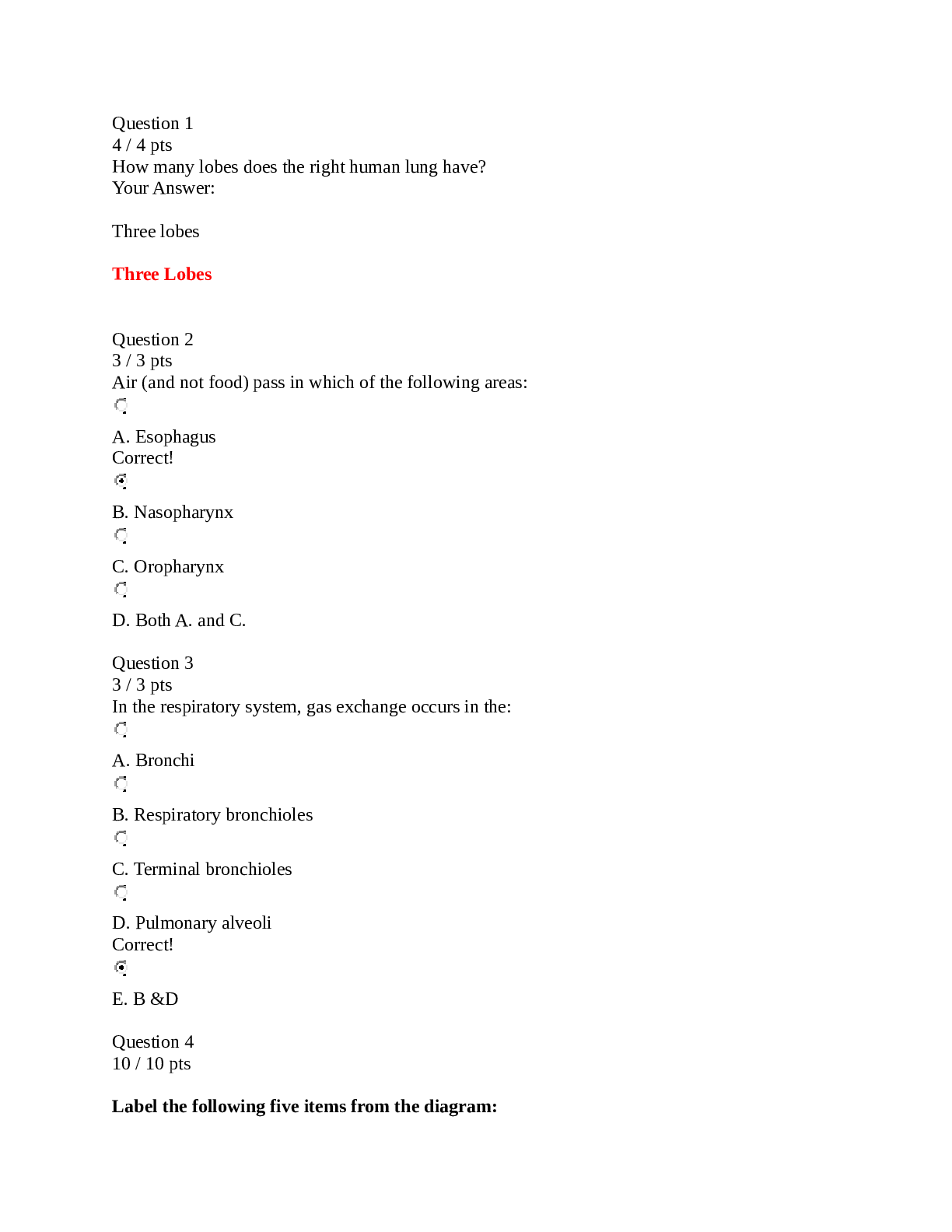
Buy this document to get the full access instantly
Instant Download Access after purchase
Add to cartInstant download
Also available in bundle (2)

A&P 1 101 Module 1-8 Exam BUNDLE Comprehensive set Portage Learning (RATED A)
A&P 1 101 Module 1-8 Exam BUNDLE Comprehensive set Portage Learning (RATED A)
By A+ Solutions 2 years ago
$14.5
8
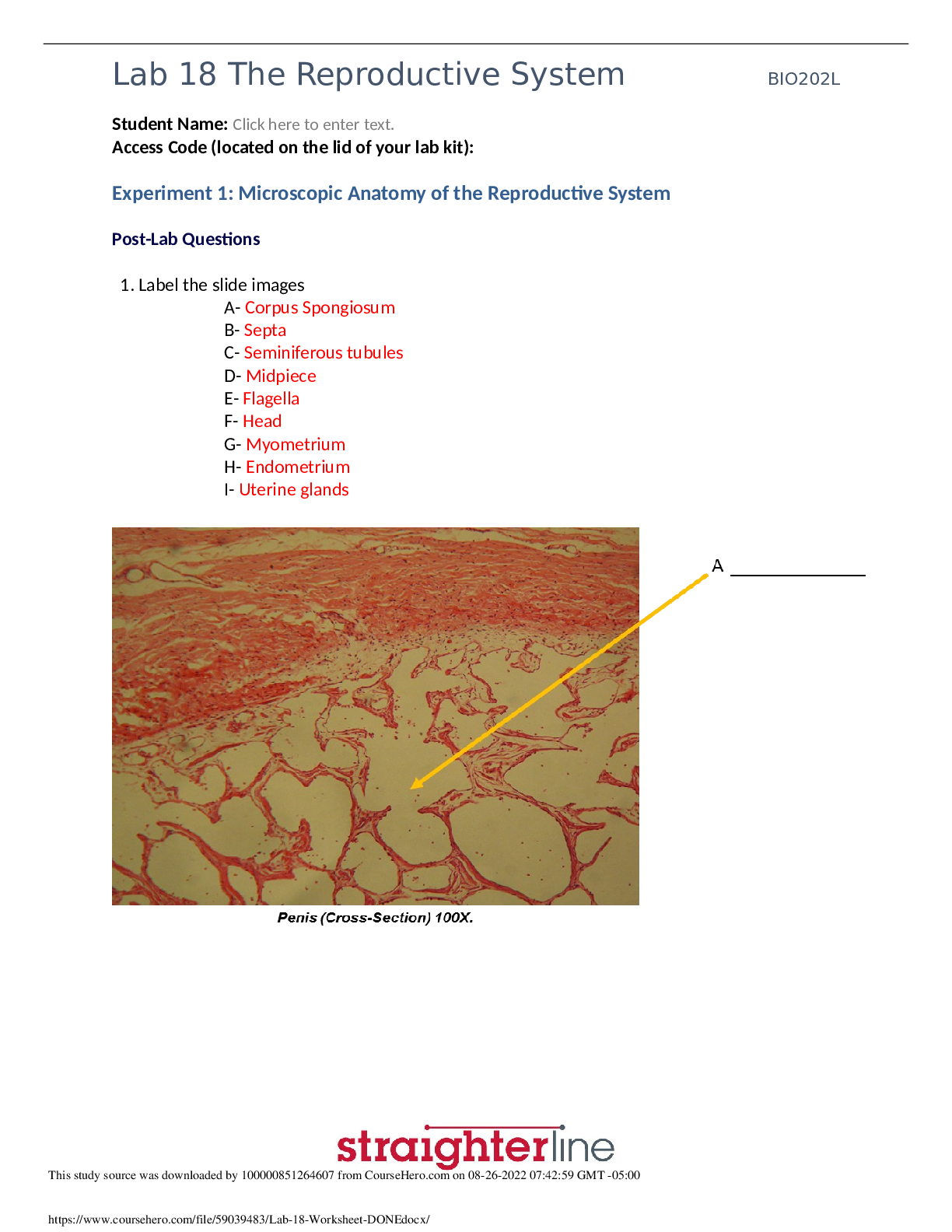
BIO 202L LAB Worksheets PACKAGE (LAB 10- LAB 18) Compiled | best Exam bundle for quick study (GUARANTEED PASS).
BIO 202L LAB Worksheets PACKAGE (LAB 10- LAB 18) Compiled | best Exam bundle for quick study (GUARANTEED PASS).
By A+ Solutions 2 years ago
$14.5
17
Reviews( 0 )
Document information
Connected school, study & course
About the document
Uploaded On
Jun 29, 2021
Number of pages
12
Written in
Additional information
This document has been written for:
Uploaded
Jun 29, 2021
Downloads
0
Views
90






.png)







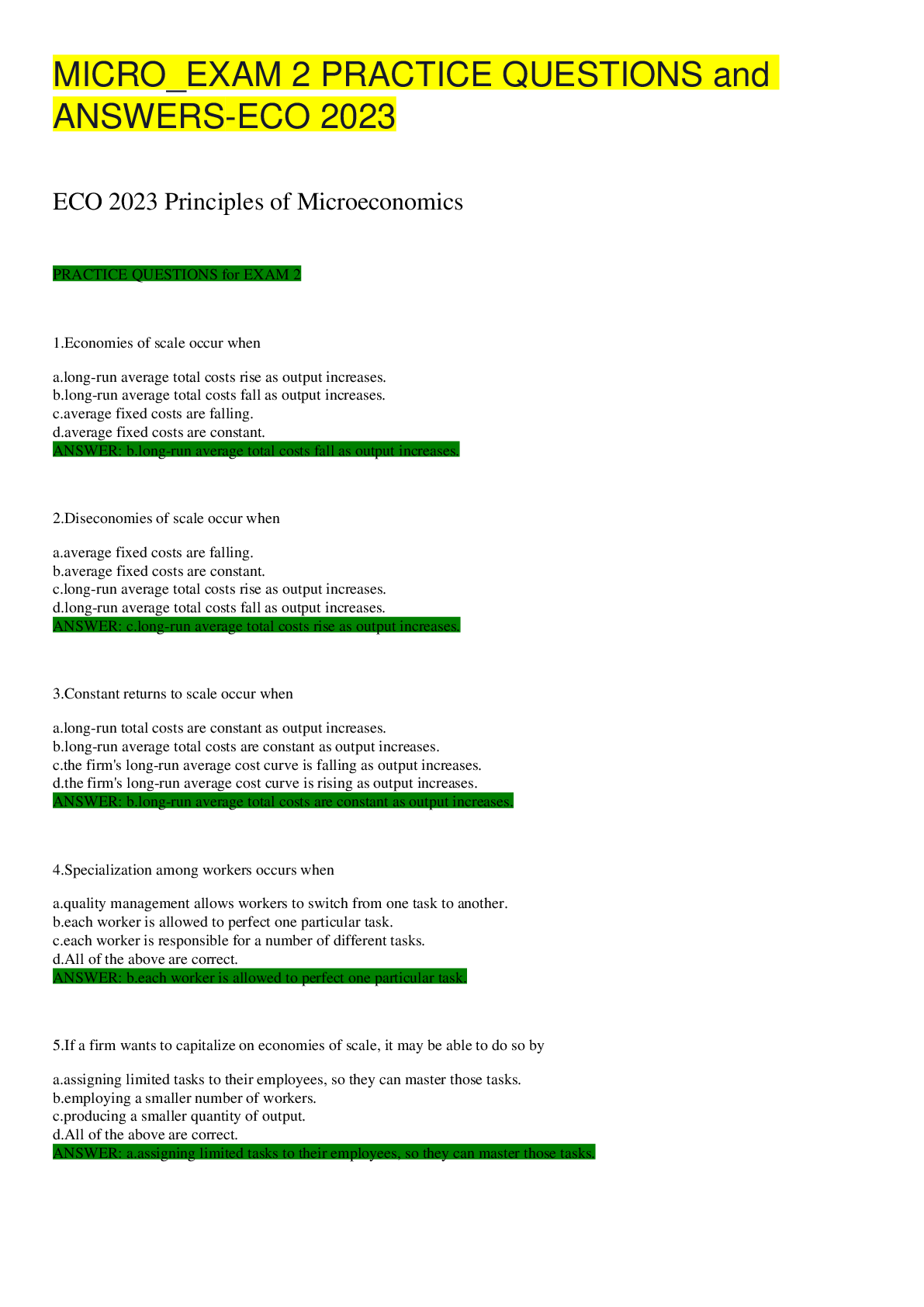


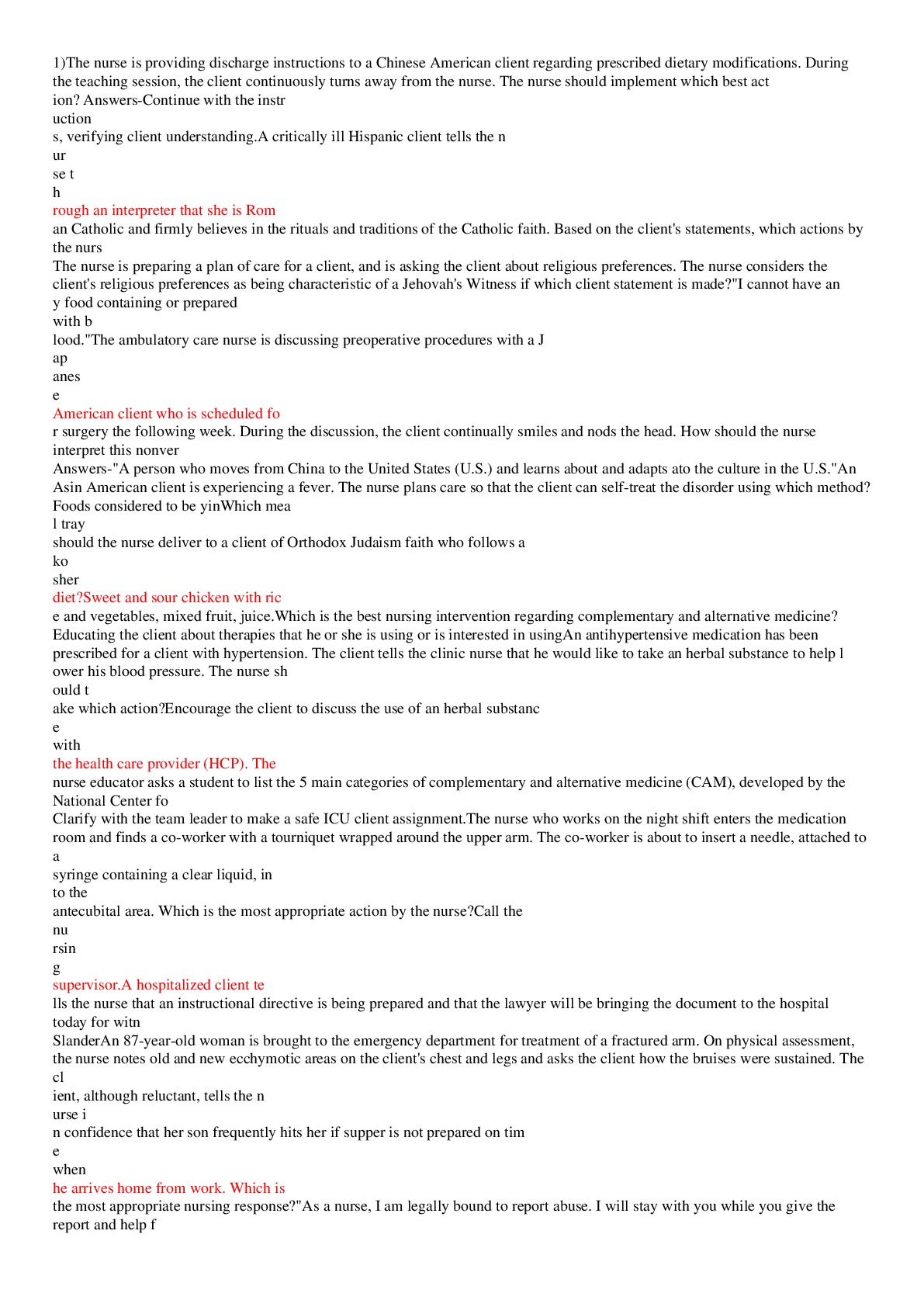
.png)


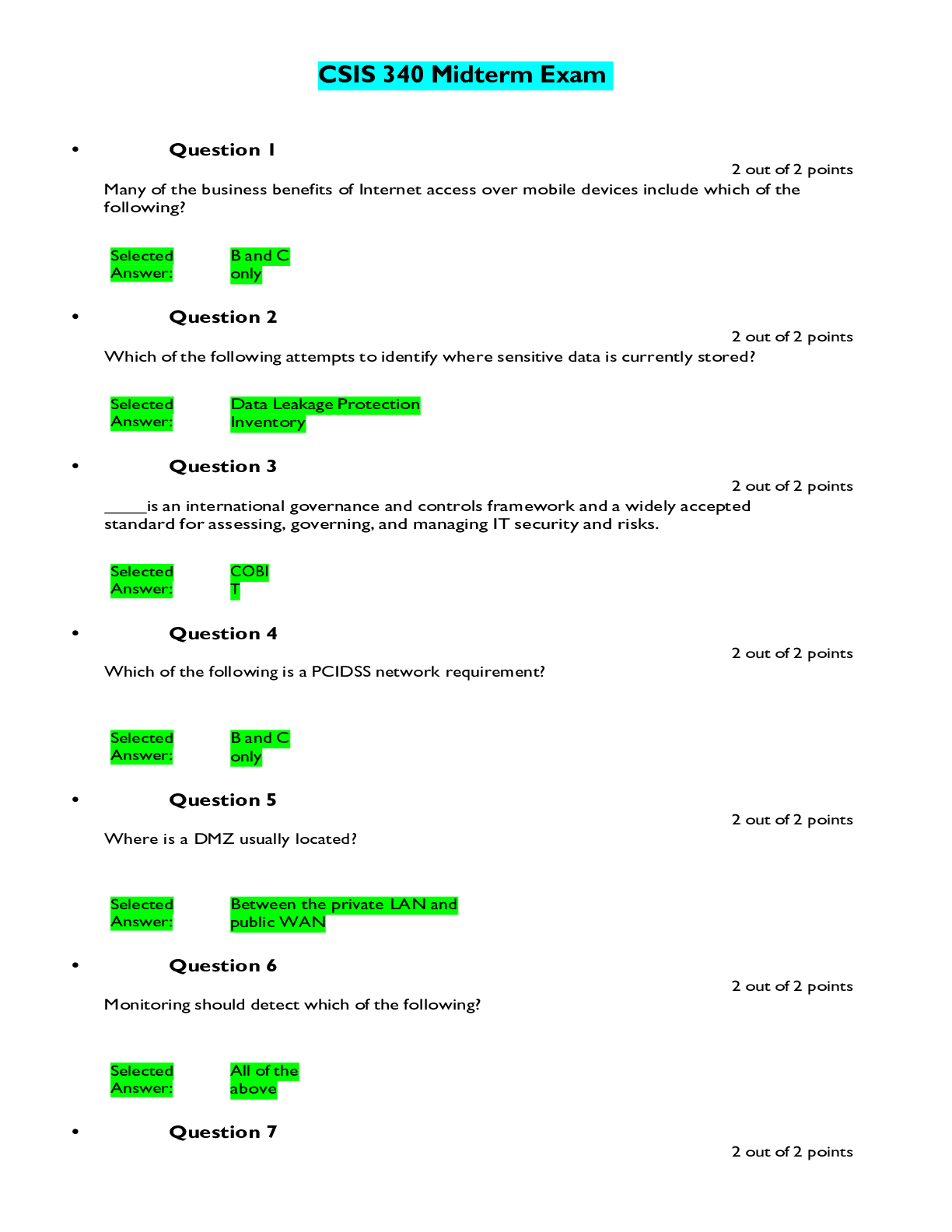

.png)

